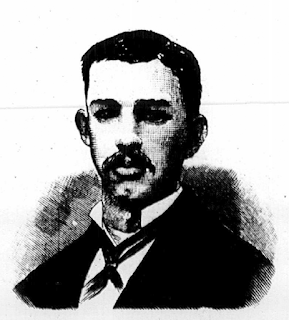
The Pregnant Woman
On September 15, 1878, three boys tending to their cows near Silver Lake Park on Staten Island found a barrel buried in a patch of soft dirt near a wagon track called Little Serpentine Road. Inside the barrel was the decomposing body of a naked woman with long, dark, braided hair. She appeared to have been pregnant.
The boys ran to New Brighton and told Sheriff Connor they had found a woman stuffed inside a barrel. The news spread quickly through the village, and soon a large crowd had gathered near the lake to watch the sheriff and his deputies remove the barrel from the shallow grave.
Dr. William C. Walser, who conducted the initial examination, discovered that the woman had been about eight months pregnant when her death occurred. Although the woman’s skull was also fractured, the doctor thought she had died in the throes of childbirth–probably from internal hemorrhaging, and possibly during a botched abortion.

At first, everyone assumed the body was that of Ellen Murphy, a woman who had been described as being “unlawfully intimate” with a Staten Island man named Louis Reige of Clifton. It didn’t take long for the rumors to begin flying that Ellen had probably been the victim of a female abortionist who lived just 300 hundred yards from the burial site.
However, Ellen’s landlady said no such thing had happened. According to her, Ellen had quit her job, packed a trunk, and left her house in August to visit family in Ireland for a few months.

A Witness Identifies the Killer
Many families came forward to claim the body during the next few days, but all leads came to a dead end (no pun intended). On September 18, the coroner ordered her remains be buried in the Potter’s Field.

Authorities finally caught a break, however, when Mr. Gustave “August” Keymer came forward with an important tip. August told Coroner Daniel Dempsey he had encountered a man digging a hole near the lake about six weeks earlier. When he asked the man what he was doing, the man said he was burying a Newfoundland dog that was inside a barrel.
August suggested the man take the dead dog somewhere else so the smell would not offend those using the lake. The man put the barrel in a wheelbarrow and wheeled it down to the ravine, where the woman’s body was later found. (This man was obviously not very bright.)

October 8, 1878
With August’s tip and additional evidence left at the crime scene, the sheriff and his deputies were finally able to identify the mystery barrel man. As additional pieces began to fall into place, they soon were convinced that the “canine undertaker” was also the Silver Lake killer.
The suspect was Edward Reinhardt, 25, who had operated a candy and tobacco store on Gore Street (now Broad Street) in Stapleton for a short time while he lived there.
According to his landlady, Mrs. Josephine Herborn, Reinhardt was married to a woman named Annie (later determined to be Mary Anne Degnan of Newark, NJ). Annie had told Mrs. Herborn that she was pregnant and worried because her husband was abusing her.
During the trial, Mrs. Herborn testified that Reinhardt had moved out of her home on July 19, 1878. Before he left, he told her that he had to deliver a heavy barrel full of crockery to his sister’s house. She did not see Annie that day, although she did hear Reinhardt call out her name the morning he left.
Rhinehardt was last seen wheeling the beer barrel up the Richmond Road (now Van Duzer Street). Annie was never seen again.


New York Public Library, 1884 map.
So Where Do the Cats Come In?
By the time the authorities caught up with Reinhardt, he was living at 132 Broome Street on Manhattan’s Lower East Side with his new wife, Pauline Ditmar, whom he had reportedly married on July 13–just six days before killing his wife. He was employed at a marble shop at 125 Attorney Street.
It was August Keymer who broke the case by identifying Reinhardt as the man he saw digging the hole. Following further investigations, Reinhardt was arrested and sent to trial for murder.
There is a lot more to this story, but in the end, Reinhardt was eventually sentenced to hang for the murder of Mary Anne Degnan Reinhardt. He was sent to the Richmond County Jail, where–when he wasn’t trying to escape–he spent his time making miniature ship models out of wood and barrel beads, painting murals on his cell wall, and conversing with three cats who shared his cell with him.
According to The New York Times, Reinhardt had raised the cats since they were kittens. For more than two years, as Reinhardt awaited his final destiny, the cats lived with him in his jail cell.

On the last night of his life, Reinhardt spent the night in the jail corridor. The “death watch” assigned to stay with him comprised sheriff deputies John G. Vaughan, John J. Warner, and C. Rutan, and police officers Fitzpatrick and Clarins.
After smoking a few cigars and tearing up a letter from his second wife telling him about their young child, Reinhardt asked Officer Fitzpatrick to take care of two of his prison cats. He requested Deputy Rutan to take charge of the third cat. I hope his final requests were granted.
The Public Execution
On January 13, 1881, the gallows from New York City’s Tombs prison were transported to the Richmond County Jail courtyard, where a temporary fence had been installed to provide some privacy. Numerous arrangements were made throughout the village to accommodate the hundreds of people expected to turn out for Staten Island’s first execution in more than 100 years.
On the morning of January 14, Reinhardt was led into the courtyard and stationed under the rope with his back to the crowd. The sheriff drew a black cap down Reinhardt’s face and gave the signal for the hangman to drop the weight at 10:04 a.m.
The attending physician pronounced Reinhardt dead at 10:17–a very long 13 minutes after the weight had dropped. Reinhardt was buried at the Silver Mount Cemetery, not far from Silver Lake.

The Last of the Executions by Hanging

The last legal execution by hanging in New York City at The Tombs took place on December 5, 1889: that of Henry “Handsome Harry” Carlton, 27, who had killed a police officer on October 28, 1888. The last legal execution by hanging in New York State took place just one day later at Brooklyn’s Raymond Street Jail. John Greenwall, 30, a tailor, was hung for being found guilty of a burglary-murder.
On January 1, 1889, a new law went into effect that required the state—rather than the county—to carry out death sentences using electricity, which was considered to be a more humane method to take someone’s life. However, individual counties continued to conduct executions by hanging until August 6, 1890, when the world’s first electrical execution took place in Auburn Penitentiary for ax-murderer William Kemmler.
If you enjoyed this tale of murder and feline friendship, check out this story about Tipsy, a midtown mouser who helped solve another gruesome murder in 1912. h


